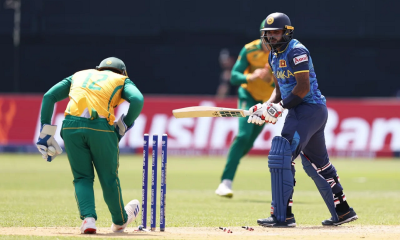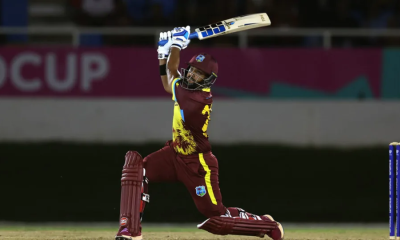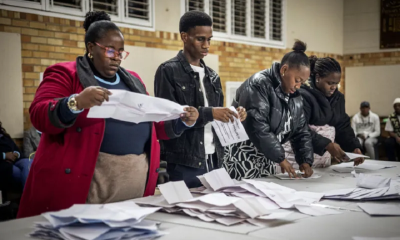Foreign News
South Africa leader under pressure after election blow

South Africa’s President Cyril Ramaphosa is under growing pressure after leading the ruling African National Congress (ANC) to its worst election result in 30 years, forcing it to share power.
With votes in from most districts, the ANC is on 40% – down from 58% at the previous election. This is lower than the party’s feared worse-case scenario of 45%, analysts say, The ANC has always polled above 50% since the country’s first democratic elections in 1994, which saw Nelson Mandela become president.
But support for the party has been dropping significantly due to anger over high levels of corruption, unemployment and crime.
Citing the cost-of-living crisis and frequent power-cuts, a woman told the BBC she ended a 30 year voting streak for the ANC in favour of the centre-right Democratic Alliance (DA) this time.
“This result is not good. I wanted it out of government. We need to give someone else a chance,” she said
The final results will be announced at 18:00 local time (17:00 BST) on Sunday, the BBC understands.
The ANC leadership has begun to consult internally to prepare for complex coalition talks.
Its options are the DA, which is in second place on 22%, the uMkhonto we Sizwe (MK) party led by former President Jacob Zuma, on 15%, or the radical Economic Freedom Fighters (EFF) with 9%.
Both the EFF and MK advocate seizing white-owned land and nationalising the country’s mines.
The MK has said it would be prepared to work with the ANC, but not while it was led by Mr Ramaphosa.
He replaced Mr Zuma as both president and ANC leader following a bitter power struggle in 2018.
MK supporters have been celebrating overnight in Durban, the biggest city in the party’s heartland of KwaZulu-Natal province. The party was only formed in December.
ANC chairperson Gwede Mantashe said his party was unlikely to form an alliance with the DA. He said there would have to be “policy alignment” between parties to form a coalition agreement.
For the ANC, its black empowerment policies – aimed at giving black people a stake in the economy following their exclusion during the racist apartheid era – were “non-negotiable”.

He added that any coalition partner would have to agree to the National Health Insurance (NHI) Bill, which promises universal health care for all, signed into law earlier this month.
The DA opposes both the NHI and the ANC’s black empowerment policies.
Despite the ANC’s reluctance to align with the DA, its leader John Steenhuisen hasn’t ruled out the idea.
Bit if an alliance with the ANC was reached there would be a few non-negotiables, he said. “Respect for the rule of law and the constitution, a social market economy that treats the private sector as partners in the growth agenda.”Zero tolerance for corruption and cadre deployment, and an absolute laser-like focus on economic policies that grow jobs.”
Mr Steenhuisen also told the BBC he would have to consult pre-election coalition partners before considering any negotiations. But he ruled out the EFF and the MK party as potential coalition partners. “I think instability is not in the best interest of the country. A coalition with the radical left in South Africa of the MK party and the EFF will produce the same policies that destroyed Zimbabwe, destroyed Venezuela,” he said.
Another option would be to work with the EFF, led by Julius Malema, a former ANC youth leader. The two parties currently form the coalition that runs the country’s biggest city, Johannesburg.
A record 70 parties and 11 independents were running, with South Africans voting for a new parliament and nine provincial legislatures.
The DA has signed a pact with 10 of them, agreeing to form a coalition government if they get enough votes to dislodge the ANC from power. But this does not include the EFF or MK, who would be needed to form a majority.
As the parties scramble to form alliances, Kenya’s former President Uhuru Kenyatta, who is leading the African Union election observer mission in South Africa, offered some advice for forming coalitions.
He said coalition governments need to focus on areas of agreement instead of differences.
“I can only wish them well and hope that the leadership will take this decision by the people in a positive frame,” he said.
(BBC)
Foreign News
Nasa ‘Earthrise’ astronaut dies at 90 in plane crash

Apollo 8 astronaut Bill Anders, who snapped one of the most famous photographs taken in outer space, has died at the age of 90.
Officials say a small plane he was flying crashed into the water north of Seattle, Washington.
Anders’ son Greg confirmed that his father was flying the small plane, and that his body was recovered on Friday afternoon. “The family is devastated. He was a great pilot. He will be missed,” a statement from the family reads.
Anders – who was a lunar module pilot on the Apollo 8 mission – took the iconic Earthrise photograph, one of the most memorable and inspirational images of Earth from space.
Taken on Christmas Eve during the 1968 mission, the first crewed space flight to leave Earth and reach the Moon, the picture shows the planet rising above the horizon from the barren lunar surface.
Anders later described it as his most significant contribution to the space programme.

The image is widely credited with motivating the global environmental movement and leading to the creation of Earth Day, an annual event to promote activism and awareness of caring for the planet.
Speaking of the moment, Anders said: “We came all this way to explore the Moon, and the most important thing that we discovered was the Earth.”
Officials said on Friday that Anders crashed his plane around 11:40PDT (1940BST).
The US National Transportation Safety Board (NTSB) said the 90-year-old was flying a Beechcraft A A 45 – also known as a T-34. The agency said that the plane crashed about 80ft (25m) from the coast of Jones Island.
Anders also served as the backup pilot to the Apollo 11 mission, the name of the effort that led to the first Moon landing on July 24, 1969.
Following Anders’ retirement from the space programme in 1969, the former astronaut largely worked in the aerospace industry for several decades. He also served as US Ambassador to Norway for a year in the 1970s.
But he is best remembered for the Apollo 8 mission and the iconic photograph he took from space.
“In 1968, during Apollo 8, Bill Anders offered to humanity among the deepest of gifts an astronaut can give. He traveled to the threshold of the Moon and helped all of us see something else: ourselves,” Nasa Administrator Bill Nelson said in a statement.
Mark Kelly, a former astronaut who now serves as a US Senator for the state of Arizona, said in a post on X, formerly Twitter, that Anders “inspired me and generations of astronauts and explorers. My thoughts are with his family and friends”.
[BBC]
Foreign News
China’s Chang’e-6 lifts off from far side of Moon with rock samples

A Chinese spacecraft carrying rock and soil samples from the far side of the Moon has lifted off from the lunar surface to start its journey back to Earth, according to state media.
The achievement on Tuesday is a world first and the latest leap for Beijing’s decades-old space programme, which aims to send a crewed mission to the Moon by 2030.
The Xinhua News Agency, citing the China National Space Administration (CNSA), said that the ascender of the Chang’e-6 probe took off at 7:38am local time on Tuesday (23:38 GMT) and entered a preset orbit around the moon.
It described the move as “an unprecedented feat in human lunar exploration history”.
The Chang’e-6 probe was launched last month and its lander touched down on the far side of the Moon on Sunday. It used a drill and robotic arm to dig up soil on and below the Moon’s surface, according to Xinhua.
After successfully gathering its samples, the Chang’e-6 unfurled China’s national flag for the first time on the far side of the Moon, it said.
The agency cited the CNSA as saying that the spacecraft stowed the samples it had gathered in a container inside the ascender of the probe as planned.
[Aljazeera]
Foreign News
China says its spacecraft lands on Moon’s far side

China says its uncrewed craft has successfully landed on the far side of the Moon – an unexplored place almost no-one tries to go.
The Chang’e 6 touched down in the South Pole-Aitken Basin at 06:23 Beijing time on Sunday morning (22:23 GMT Saturday), the China National Space Administration (CNSA) said.
Launched on 3 May, the mission aims to collect precious rock and soil from this region for the first time in history. The probe could extract some of the Moon’s oldest rocks from a huge crater on its South Pole.
The landing was fraught with risks, because it is very difficult to communicate with spacecraft once they reach the far side of the Moon. China is the only country to have achieved the feat before, landing its Chang’e-4 in 2019.
After launching from Wenchang Space Launch Center, the Chang’e 6 spacecraft had been orbiting the Moon waiting to land. The lander component of the mission then separated from the orbiter to touch down on the side of the Moon that faces permanently away from Earth.
During the descent, an autonomous visual obstacle avoidance system was used to automatically detect obstacles, with a visible light camera selecting a comparatively safe landing area based on the brightness and darkness of the lunar surface, the CNSA was quoted as saying by state-run Xinhua news agency.
The lander hovered about 100m (328ft) above the safe landing area, and used a laser 3D scanner before a slow vertical descent. The operation was supported by the Queqiao-2 relay satellite, the CNSA said.
Chinese state media described the successful landing as an “historic moment”. The state broadcaster said “applause erupted at the Beijing Aerospace Flight Control Center” when the Chang’e landing craft touched down on the Moon early on Sunday morning.
The lander should spend up to three days gathering materials from the surface in an operation the CNSA said would involve “many engineering innovations, high risks and great difficulty”. “Everyone is very excited that we might get a look at these rocks no-one has ever seen before,” explains Professor John Pernet-Fisher, who specialises in lunar geology at the University of Manchester.
He has analysed other lunar rock brought back on the American Apollo mission and previous Chinese missions. But he says the chance to analyse rock from a completely different area of the Moon could answer fundamental questions about how planets form.
Most of the rocks collected so far are volcanic, similar to what we might find in Iceland or Hawaii. But the material on the far side would have a different chemistry . “It would help us answer those really big questions, like how are planets formed, why do crusts form, what is the origin of water in the solar system?” the professor says.
The mission aims to collect about 2kg (4.4lb) of material using a drill and mechanical arm, according to the CNSA.
The South Pole–Aitken basin, an impact crater, is one of the largest known in the solar system.
From there, the probe could gather material that came from deep inside the lunar mantle – the inner core of the Moon – Prof Pernet-Fisher says.
The Moon’s South Pole is the next frontier in lunar missions – countries are keen to understand the region because there is a good chance it has ice.

The capsule in the last Chinese moon mission, Chang’e 5, brought back soil and rocks in 2020 (BBC)
Access to water would significantly boost the chances of successfully establishing a human base on the Moon for scientific research.
If the mission succeeds, the craft will return to Earth with the precious samples on board a special return capsule.
The material will be kept in special conditions to try to keep it as pristine as possible.
Scientists in China will be given the first chance to analyse the rocks, and later researchers around the world will be able to apply for the opportunity too.
This is the second time China has launched a mission to collect samples from the Moon.
In 2020 Chang’e 5 brought back 1.7kg of material from an area called Oceanus Procellarum on the Moon’s near side.
China is planning three more uncrewed missions this decade as it looks for water on the Moon and investigates setting up a permanent base there.
Beijing’s broader strategy aims to see a Chinese astronaut walk on the moon by around 2030.
The US also aims to put astronauts back on the moon, with Nasa aiming to launch its Artemis 3 mission in 2026.
(BBC)
























